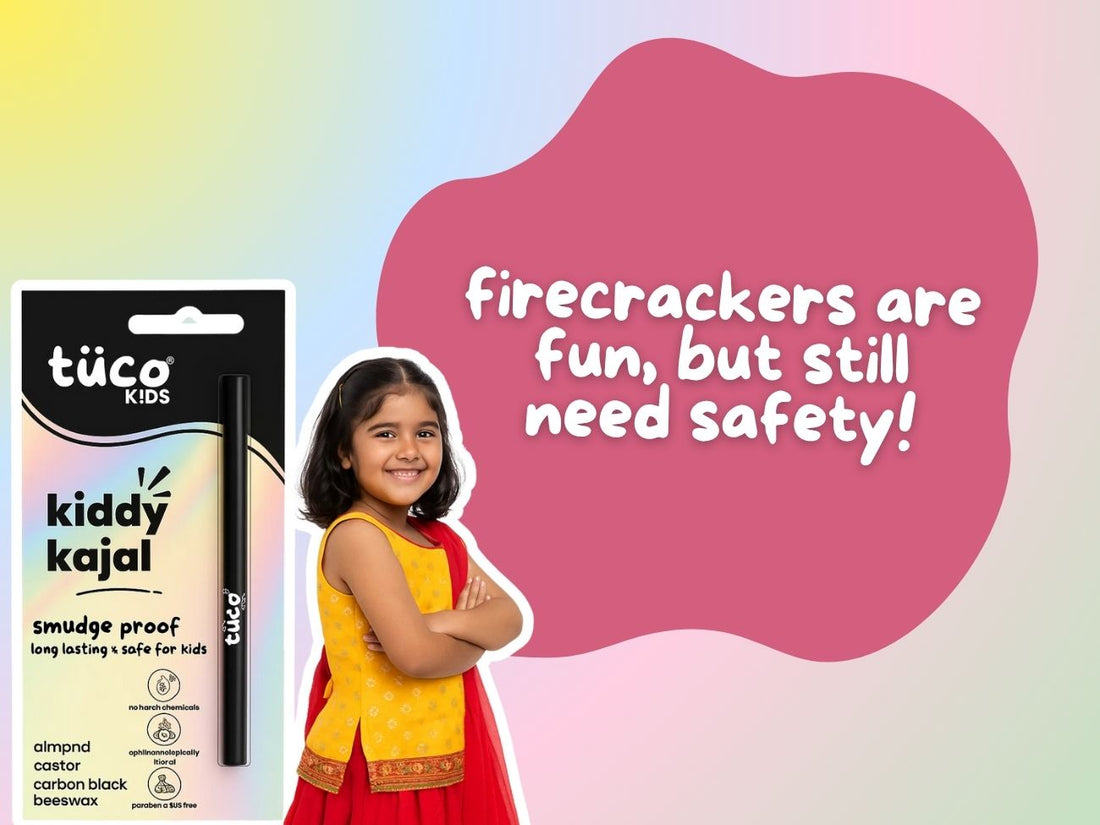
Firecracker Safety Tips for Children: What’s Safe, What’s Not, and How to Supervise
Share
For children, Diwali often means one thing - fireworks! The sparkling lights, crackling sounds, and bursts of color fill them with excitement and wonder. But as parents know, firecrackers are not just fun; they also come with safety concerns.
From burns and smoke to air and noise pollution, it’s essential to teach kids how to enjoy Diwali responsibly. This guide helps parents understand which firecrackers are safe for kids, which need strict supervision, and how to make celebrations both fun and safe for everyone.
What Makes Firecrackers Harmful?
Most firecrackers contain chemicals like sulphur, potassium nitrate, and charcoal, and colorants made from heavy metals such as lead, barium, and copper.
When burned, these release:
-
Toxic gases (like carbon dioxide and sulphur dioxide) that pollute the air and irritate lungs.
-
Metal particles that can harm skin, eyes, and the respiratory system.
-
Noise levels that exceed safe limits for young children’s ears.
Parent Insight: Instead of bursting dozens of crackers, encourage your child to enjoy just a few; focus more on the joy of light than the noise. You can also explore eco-friendly or “green” firecrackers, which emit less smoke and sound. Additionally, consider discussing with your child the health risks of firecracker smoke, as it can be harmful to both humans and the environment. Engaging in quieter celebrations can also create a more peaceful atmosphere for everyone involved, allowing for meaningful connections and conversations. Finally, finding alternative ways to celebrate, such as enjoying festive lights or community events, can enhance the experience while minimizing any negative impacts.
How Pollution from Firecrackers Affects Children
The smoke and fine dust left behind after fireworks can linger in the air for hours, and these particles often stick to the skin, hair, and even clothes. This can cause:
-
Skin irritation or dryness due to chemical residue settling on exposed areas like arms and face.
-
Eye redness or watering, especially in children who spend time outdoors during fireworks.
-
Throat irritation and coughing from inhaling fine dust particles mixed with gases.
-
Worsening of allergies or asthma, particularly in sensitive children.
-
General fatigue or headaches from continuous exposure to smoke and noise.
Parent Insight: The effects may seem small at first but can build up. It’s always a good idea to ensure kids wash up thoroughly after fireworks, wear protective cotton clothing, and stay hydrated.
Tuco Kids offers a complete festive care range to keep children’s skin and hair healthy after all the Diwali fun. Gentle bathing bars cleanse without dryness, nourishing lotions restore softness, and mild shampoos with detanglers wash away smoke and dust, leaving hair fresh, smooth, and easy to manage.
And for a little festive sparkle, Tuco’s safe lip balms and more make-up range that can add gentle color and also protection; a perfect, kid-friendly alternative to makeup during celebrations.
Every Tuco product is non-toxic, pH-balanced, and dermatologist-tested, ensuring your child’s care routine stays as safe and joyful as the celebration itself.
Firecrackers That Are Generally Safe for Kids
While no firecracker is 100% risk-free, some are considered safer options for children when used under adult supervision.
1. Sparklers (Phuljhadis)
A classic favorite among kids! Handheld sparklers produce beautiful light trails and are relatively safe when held correctly.
Safety Tip: Always hold at arm’s length, never point toward others, and light one sparkler at a time.
2. Flower Pots (Anaar)
They stay on the ground and emit colorful showers of sparks. Perfect for kids to watch from a safe distance.
Safety Tip: Keep a 6-foot distance and never lean over while lighting.
3. Ground Spinners (Chakri)
These spin in circles on the ground with bright lights and buzzing sounds. Kids love the movement and sparkle!
Safety Tip: Light with a long candle or sparkler, never with a short matchstick.
4. Poppers & Confetti Bombs (Paper-based)
A safer alternative that uses air pressure to release colorful paper or streamers.
Safety Tip: Choose non-plastic, biodegradable poppers that make little noise.
Parent Insight: These firecrackers allow children to enjoy the sparkle and excitement of Diwali without overwhelming sound or smoke, keeping the celebration bright but gentle.
Firecrackers That Need Strict Supervision
Certain firecrackers should only be used when parents or adults are closely supervising or avoided entirely for younger children.
1. Rockets
They can be unpredictable in direction and may land in unsafe areas.
Safety Tip: Use only in open spaces and never in crowded neighborhoods.
2. Bombs (Ladi or Chain Crackers)
These are extremely loud and can exceed 125 decibels, which is harmful for children’s ears and can frighten pets.
Safety Tip: Avoid them altogether; they add noise, not joy.
3. Sutli Bombs & Flash Crackers
These emit intense light flashes and sudden bursts that can cause burns or eye injury.
Safety Tip: Not suitable for children under any circumstances.
How Parents Can Supervise Firework Play Safely
-
Choose an Open, Safe Area: Always burst firecrackers outdoors, away from trees, vehicles, or electrical lines.
-
Wear Protective Clothing: Encourage kids to wear cotton clothes and closed shoes. Avoid loose or synthetic materials.
-
Keep Water & First Aid Nearby: Always have a bucket of water and a basic first aid kit ready.
-
No Cracker Sharing: Light one cracker at a time, never multiple together.
-
Never Relight: If a cracker doesn’t burst, wait and then dispose of it safely, never attempt to relight.
-
Keep Distance: Maintain a safe radius for each cracker type — especially rockets and chakris.
Parent Insight: Make firecracker time a family activity where adults set examples of safety, patience, and care. Kids mirror your calmness more than your words.
Eco-Friendly Firecracker Alternatives
For a truly safe and sustainable celebration, explore these fun alternatives:
-
LED light shows or glow-stick games for kids.
-
Eco-friendly diya painting or lantern crafts.
-
Paper fireworks made by kids with colors and glitter.
-
Community fireworks shows instead of home bursting - less pollution, more fun!
Parent Insight: This approach lets children feel the magic of Diwali without harming the planet or their health.
Pollution & Health: Why Moderation Matters
After a few hours of fireworks, the air fills with smoke and dust. This can cause:
-
Breathing difficulties for children, especially those with asthma.
-
Skin irritation and itching from residue or chemical contact.
-
Eye discomfort due to smoke particles.
Encourage moderation and explain to children how even a few fireworks can bring joy while protecting the air they breathe.
Final Thoughts
Diwali fireworks can be magical when celebrated responsibly. By teaching children what’s safe, what’s not, and how to stay mindful, parents can make the festival both exciting and safe.
A child’s Diwali should always sparkle with joy, awareness, and gentle care — a celebration of light, not noise.

